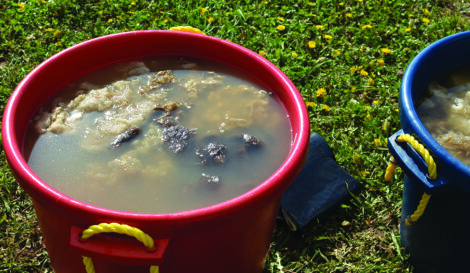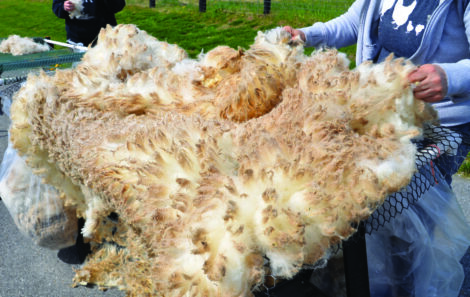Learn about small-scale wool processing and how to process raw wool and fleece by caring for and storing it correctly.
Once you become a shepherd for sheep, goats, or other fiber animals, you’ll have a renewable source of raw product every year. However, the fleece shorn from the animals will stack up if you don’t process it.
Thankfully, you don’t need to process fleece every year. You may only raise three animals and not meet the minimum weight requirement for incoming fleece at the mill. In that case, storing fleece for up to two years and then processing it is a good option. If stored correctly, fleece can be kept for years and still process nicely.
Cloth, paper, and canvas bags — even pillowcases — are all preferable over plastic bags for storing fleece, though plastic bags are convenient for collecting wool at the time of shearing. Any bags made of poly cloth aren’t recommended, as poly fibers will degrade the quality of the wool if pieces of fiber are left in it. In addition, should you choose to sell to a wool pool, poly fibers aren’t acceptable. Plastic bins with lids are OK to use; they allow air to circulate with the fiber and keep it clean. Regardless of how you store your wool, I recommend skirting it to remove dirty sections and large pieces of vegetable matter.
When storing, don’t compress the fiber too tightly in the bags. Over time, that can result in matted fiber. Mark each bag or box with the animal’s name, year sheared, weight of fiber (if needed), and any other information you care to note.
How to Process Raw Wool
A lot goes into making a fine yarn before you purchase it. The sheep shearer and I work closely together during shearing to remove the fleece in good condition and transport it from the shearing field. Both the shearer and the mill owner give me feedback that helps me improve the fleeces from my flock. Evaluating the fleece and listening to feedback will help you grow a better fleece the following year.
Some points to consider when examining your fleece or mohair fiber:
- Are there weak areas in the fleece?
- Do you see any wool break in the locks?
- Are the tips of the locks tender and easily broken off?
If you spot some of these problems in your fleeces, it may just indicate a benign issue, or it may mean a more serious complication, such as an illness in the flock.

Skirting 101
Skirting is the process of separating the inferior wool from the rest of the sheared fleece. When skirting, discard wool from the head, lower legs, and belly, and any urine-soaked areas. If the animal was accidentally cut during the shearing and bled on the wool, also remove that section. Lastly, discard any matted wool with fecal material, short pieces, or areas heavily contaminated with vegetation. If working outdoors, plan to skirt your fleece on a dry, sunny day so you won’t damage it.
Important things to remove from the fleece while skirting include:

Second cuts. These are short pieces of fiber caused by the shears going over the same area more than once. Some second cuts will fall through the skirting tables; the rest need to be manually removed.
Cotted fleece. Cotted fleece is matted fleece with locks that are difficult to separate, which occurs when moisture causes the fleece to felt near the animal’s skin and further into the locks. Some cotted fleeces can be used for felting projects if the wool isn’t too damaged.
Breech (or britch) wool. This is the coarse hair fiber on the lower hind legs.
Vegetable matter. This includes any burrs, grain, stickers, etc.

Wool breaks and tenderness. Tender or brittle fibers crackle when you hold a lock up to your ear and pull at both ends. This can result from illness, stress, pregnancy and delivery, feeding changes, and weather. It might be usable for hand-spinning fleece, but often, it won’t work on a larger fiber mill setup. Sometimes just the tips are tender; in this case, if the staple length is long enough, snap off the tips, and you can process the remaining fleece.
Stains. Stains should be evaluated based on what caused the discoloration. “Yolk” is a stain caused by perspiration and skin oil combining. It can harden on the wool, but with the proper washing temperature, it’ll wash out of the fleece. Bright-yellow “canary” stains, on the other hand, are caused by a parasite that eats lanolin and wool, and may have a strong odor. Don’t make the mistake of thinking this is the same as yolk. Discard fleece contaminated with canary stain.
Any other stains that won’t wash out, such as urine, manure, paint, or blood, should be removed from the good portions of the fleece. If you use tattoo ink for animal identification, the ink can also cause stains.

Insects or rodents. Don’t send any fleeces with insects or rodents to a fiber mill for processing. Mites, lice, and moths can contaminate other fleeces at the mill. Rodents will damage fleeces during storage, and no one wants to be greeted by a family of mice come processing time.
After skirting is complete, the remaining fleece should be clean, with uniform staple length for spinning into yarn.
Thoroughly skirting a fleece will yield a more valuable product for the hand spinner. If you decide to continue processing the wool into roving or yarn, proper skirting will ensure you have a well-prepared product.

Scouring and Washing Fleece
It’s possible to wash your fleeces at home. You’ll need access to hot water, large washtubs or plastic bins, and a good-quality wool-washing soap (my favorite is Unicorn Scour).
After skirting, transfer the fleece in sections to mesh laundry bags. Fill a large plastic tub or utility sink, if you have one, with hot water.
Before you add the wool, add your wool-washing soap to the water according to the weight of the fiber and the directions on the bottle.
Wearing rubber gloves, submerge a bag or two at a time into the water. Don’t agitate the fiber or squeeze the bags while washing. For fleece that’s already fairly clean, drain the dirty water after 30 minutes. For soiled fleece, soak it overnight in the soapy water, and drain the water in the morning. Continuously wash the fleece and drain the tub, until the drained water runs clean.

To rinse, fill the tub with hot, clean water. Soak the fleece to remove any lingering soap. You may need more than one rinse to remove all the soap. Gently press water from the bags; don’t wring or twist!
Using drying racks, or skirting tables covered with a clean bedsheet, spread the fiber out to dry in a safe location.
Allow the fiber to dry completely. Turn the fiber from time to time to make sure it’s getting even air circulation.

Janet Garman is a farmer and freelance writer in Maryland. This is excerpted with permission from her book, The Good Living Guide to Keeping Sheep and Other Fiber Animals: Housing, Feeding, Shearing, Spinning, Dyeing, and More (copyright 2019 by Good Books, an imprint of Skyhorse Publishing Inc.).







